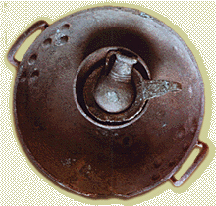Labor+Crafts
| Trade
| Phoenicians
| Glossary
| Bibliography
| Activities
The Royal Drink, the Queen of Trees
Wine and olive oil come from plants that must be
pruned for several years before bearing fruit. Both are
processed by crushing in special presses. For these reasons,
they represent an initial investment of some risk to the
farmer. Grape juice and olive oil are transformed both
physically and chemically in the course of their extraction,
processing and storage. There can be significant variation
in the flavor and structure of the end product in the
eastern Mediterranean, thus creating the potential for
connoisseurship and differential value.

wine set
inclucding a jar with residual traces of wine
on the bottom
|
The harvesting of grapes took place in August
and September and was a joyous occasion for the
community. The grapes were dried in the sun and
then pressed by barefoot treading, accompanied by
dancing and songs. Once the grape juice was
collected in a vat, fermentation would begin. After
an initial period of vat fermentation, the wine was
transferred to jars or skins for additional
fermentation. Wine would be allowed to age, as
older wine was preferred over new. Before drinking,
the wine had to be strained and was usually mixed
with water. Wine was often flavored with spices and
resins for diversity of taste. Additionally, other
fruits such as dates and pomegranates were pressed
and fermented to make fruit wines.
|
|
Olives were pressed in stone presses. The
recovered oil was stored in jars, such as the
pithoi containers in the exhibit's reconstructed
house. Olive oil was used in cooking, both in
frying and as an ingredient in recipes. It could be
flavored with spices and used as a condiment.
Scents could be added to the oil and used as
perfume. Olive oil was also kept in small lamps and
burned to illuminate the house.
Already in the Bronze
Age, regional variations in wine and
olive oil were recognized and valued. The proper
presentation and consumption of wine became a
symbol of status and power, as witnessed by
elaborate wine vessels and the importance of
banqueting. In the exhibit is displayed a bronze
banqueting bowl and ladle from Gibeon.
The commercial value of Levantine varieties
of wine and olive oil lay in their attractiveness
to people in neighboring lands. By the beginning of
the Early Bronze Age, both wine and olive oil were
exported to Egypt. At Gibeon, the excavators found
a commercial-scale winery with storage capacity for
25,000 gallons. The wine jars were inscribed in
palaeo-Hebrew writing, indicating the vineyard
owner for each jar.
|
|




